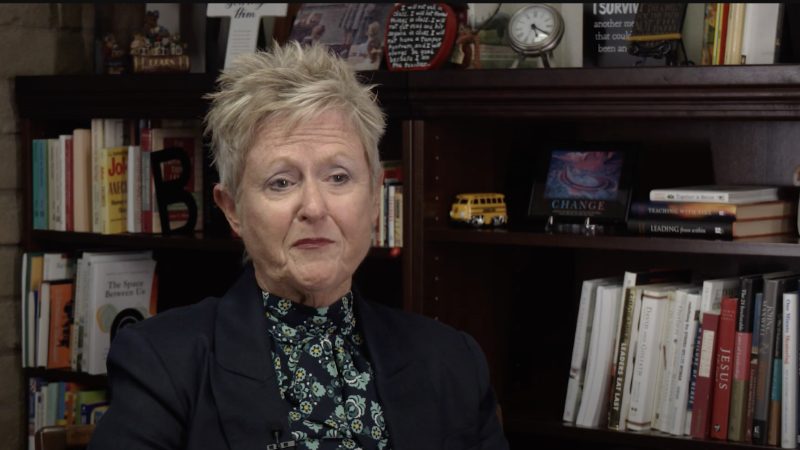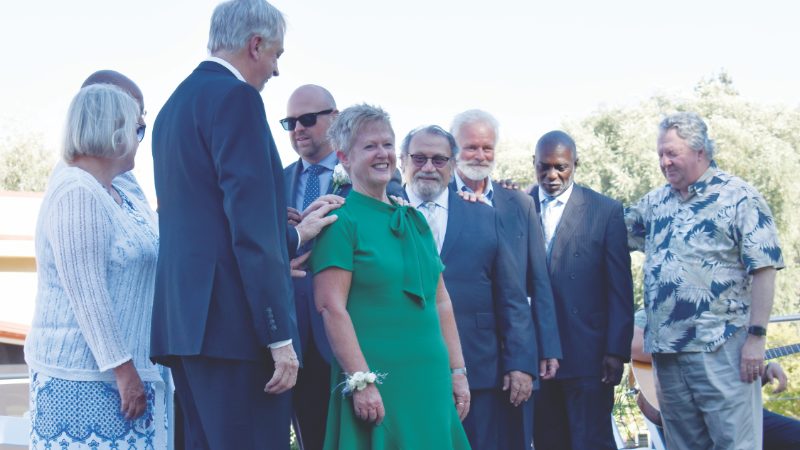By the Recorder editorial staff

In 1900, Ellen White, 72 years old, had just returned from nine years in Australia. Having sold her home in the U.S. before leaving for Australia, she needed to find somewhere to live.
Previously she had lived in the East, but now she believed the West was where she needed to be. In fact, ever since her first visit to California in 1872 she had dedicated much time and even personal funding to building up the work in the West. Her many assignments and calls on her services left little time for house hunting.
However, she recognized the importance of finding a place to call home, so as soon as she arrived in San Francisco she went looking: “For several days after reaching Oakland we spent the time in Oakland house hunting, to find a place to locate our families. We found nothing that was suitable, and I said, ‘I am done. I shall search no more. The Lord knows what our work is and where we should be located; and we shall wait the Lord’s time’” (Ellen G. White, Manuscript Releases, vol. 21, p. 126).
However, a friend told her about a place near St. Helena. So: “As soon as we could, we went down to see the place, and we were well pleased with it. It is just the place I need,” she wrote. In fact, it was better than the home she had just left in Australia. She continued, “The Lord planned for me, and I found that I could buy this place here for less than I received for my house in Cooranbong and all its belongings. This includes two horses, one rather old, four carriages and a platform wagon, much better than the one I gave away, and a house furnished throughout. It was like stepping out of my home in Cooranbong into a beautiful, roomy one here. It has surprised me much that we should be thus favored.… This place was none of my seeking. It has come to me without a thought or purpose of mine. The Lord is so kind and gracious to me. I can trust my interests with Him who is too wise to err and too good to do me harm” (Ellen G. White, Manuscript Releases, vol. 21, pp.126-127).
The Lord is so kind and gracious to me. I can trust my interests with Him who is too wise to err and too good to do me harm.
History
Elmshaven had been the property of Robert Pratt, a railroad investor. Later he became assistant general superintendent of the Southern Pacific Railroad. While involved in this work, he had the house later known as Elmshaven constructed in 1885 as his family home. However, by early 1900, his children had grown up and left home, so the “Robert Pratt Place,” as it was known, was put up for sale, along with its 74 acres and half interest in Crystal Spring.
William, Robert’s brother, had become a Seventh-day Adventist in 1873. In 1877 he donated 10 acres of his hillside land and his half interest in Crystal Spring, as well as providing financial backing, in order to establish a medical institution known as the Rural Health Retreat (now Adventist Health St. Helena). This institution was what had brought Ellen White into the area, and her decision to locate close by provided a mutually beneficial relationship.
The significance of Elmshaven

But it is for Ellen White’s writing that Elmshaven is most remembered. As one of the co-founders of the Seventh-day Adventist Church, she had spent much of her life helping her husband, James White, who served three one-year terms as president of the church. In her own right she spent much time directing the development of the church in its many areas of interest.
But as she set up home in Elmshaven, she recognized her main role was to help coming generations in their Christian experience. She wanted to get it all down on paper before she was gone. She wrote eloquently: “Occasionally I have attended meetings, and have visited institutions in California, but the greater portion of the time since the last General Conference has been spent in manuscript work at my country home, ‘Elmshaven,’ near St. Helena. I am thankful that the Lord is sparing my life to work a little longer on my books. O, that I had strength to do all that I see ought to be done! I pray that he may impart to me wisdom, that the truths our people so much need may be presented clearly and acceptably. I am encouraged to believe that God will enable me to do this” (Ellen G. White, “Courage in the Lord,” Review and Herald, June 12, 1913, p. 557).









During her life, Ellen White completed about 40 books, including nine major works she wrote in the upper writing room at Elmshaven. She also wrote materials later used as compilations, in addition to many hundreds of articles for church journals. Some have been translated and published in as many as 160 languages.
Last days
As she entered her writing room at noon on Sabbath, February 13, 1915, she fell and fractured her hip. It was in this room in a hospital bed that she spent the last few months of her life and, on Friday afternoon, July 16, 1915, closed her lifework. Her last words were, “I know in whom I have believed.”
Soon after Ellen White’s death in 1915, the Elmshaven property was sold. As it passed through several hands, the farmland to the east of the family orchard and home was disposed of and turned into residential building lots. To bring the residence and land to the south and west into Seventh-day Adventist control, Charles T. Everson, a prominent Adventist evangelist, purchased it in 1927.
After Charles Everson’s death in 1956, Mrs. Everson made the property available to the Pacific Union Conference, which now owns and maintains it with the cooperation of the General Conference.
Pioneros adventistas en el oeste
Comienzos: Elmshaven
Por el personal del Recorder

En 1900, Ellen White, a los 72 años de edad, acababa de regresar después de nueve años en Australia. Después de haber vendido su casa en los Estados Unidos antes de irse a Australia, necesitaba encontrar un lugar donde vivir.
Anteriormente había vivido en el este, pero ahora creía que el oeste era donde tenía que estar. De hecho, desde su primera visita a California en 1872 había dedicado mucho tiempo e incluso fondos personales a edificar la obra en el oeste. Sus muchas asignaciones y llamados a servir le dejaban poco tiempo para buscar donde vivir.
Sin embargo, reconoció la importancia de encontrar un lugar al que llamar su hogar, por lo que tan pronto como llegó a San Francisco puso manos a la obra: «Durante varios días después de llegar a Oakland pasamos tiempo en Oakland buscando casas, para encontrar un lugar donde ubicar a nuestras familias. No encontramos nada que fuese adecuado, y dije: “Ya basta. No buscaré más. El Señor sabe cuál es nuestra labor y dónde debemos estar ubicados; y esperaremos al tiempo del Señor”» (Ellen White, Manuscript Releases, vol. 21, pág. 126).
Sin embargo, una amiga le habló de un lugar cerca de Saint Helena. Así que: «Tan pronto como pudimos, fuimos a ver ese lugar, y quedamos muy satisfechos con él. Es justo el lugar que necesito», escribió. De hecho, era mejor que la casa que acababa de dejar en Australia. Ella continuó: «El Señor lo dispuso para mí y descubrí que podía comprar ese lugar aquí por menos de lo que recibí por mi casa en Cooranbong y todas sus pertenencias. Eso incluye dos caballos, uno bastante viejo, cuatro carruajes y un carro de plataforma, mucho mejor que el que regalé, y una casa totalmente amueblada. Así que fui de mi casa en Cooranbong a una hermosa y espaciosa [casa] aquí. Me ha sorprendido mucho que seamos tan favorecidos... Este lugar no estaba entre los que había buscado. Ha llegado a mí sin haberlo considerado o habérmelo propuesto. El Señor es tan bondadoso y misericordioso conmigo. Puedo confiar mis intereses a aquel que es demasiado sabio para errar y demasiado bueno para hacerme daño» (Ellen White, Manuscript Releases, vol. 21, págs. 126 y 127).
Historia
Elmshaven había sido propiedad de Robert Pratt, un inversor ferroviario que tarde se convirtió en superintendente general adjunto de Southern Pacific Railroad. Mientras estaba involucrado en ese trabajo hizo construir la casa, más tarde conocida como Elmshaven, en 1885 como su hogar. Sin embargo, a principios de 1900, sus hijos habían crecido y se habían ido de casa, por lo que el «Robert Pratt Place», como se le conocía, se puso a la venta, junto con sus 74 acres y la mitad de los intereses en Crystal Spring.
William, el hermano de Robert, se había convertido en adventista del séptimo día en 1873. En 1877 donó 10 acres de su tierra en la ladera de la colina y su participación en Crystal Spring, además de proporcionar apoyo financiero, con el fin de establecer una institución médica conocida como Rural Health Retreat (ahora Adventist Health St. Helena). Esa institución fue lo que trajo a Ellen White a la zona, y su decisión de establecerse cerca produjó una relación mutuamente beneficiosa.
La importancia de Elmshaven

Pero es por los escritos de Ellen White que Elmshaven es más recordado. Como una de las cofundadoras de la Iglesia Adventista del Séptimo Día, había pasado gran parte de su vida ayudando a su esposo, James White, quien sirvió tres períodos de un año como presidente de la iglesia. Por derecho propio, dedicó mucho tiempo a dirigir el desarrollo de la iglesia en sus muchas áreas de interés.
Pero cuando se estableció en Elmshaven reconoció que su papel principal era ayudar a las generaciones futuras en su experiencia cristiana. Quería plasmarlo todo en papel antes de no estar más. Escribió elocuentemente: «De vez en cuando he asistido a reuniones y he visitado instituciones en California, pero la mayor parte del tiempo desde la última Conferencia General lo he pasado trabajando en manuscritos en mi casa de campo, “Elmshaven”, cerca de Saint Helena. Estoy agradecida de que el Señor me esté permitiendo vivir para trabajar un poco más en mis libros. ¡Oh, si tuviera fuerzas para hacer todo lo que veo que debe hacerse! Ruego que me imparta sabiduría, para que las verdades que tanto necesita nuestro pueblo se presenten clara y aceptablemente. Me anima a creer que Dios me capacitará para hacerlo» (Ellen G. White, “Courage in the Lord,” Review and Herald, 12 de junio de 1913, p. 557).









A lo largo de su vida Ellen White escribió unos 40 libros, entre ellos nueve obras importantes que escribió en la habitación superior de Elmshaven. También escribió material que más tarde se usó en compilaciones, además de muchos cientos de artículos para revistas de la iglesia. Algunos han sido traducidos y publicados en unos 160 idiomas.
Últimos días
Al entrar en su sala de escritura al mediodía del sábado 13 de febrero de 1915, se cayó y se fracturó la cadera. Fue en esa habitación de una cama de hospital donde pasó los últimos meses de su vida y, en la tarde del viernes 16 de julio de 1915, cerró la obra de su vida. Sus últimas palabras fueron: «Yo sé en quién he creído».
Poco después de la muerte de Ellen White en 1915, la propiedad de Elmshaven fue vendida. A medida que pasó por varias manos, las tierras de cultivo al este del huerto y la casa se convirtieron en lotes residenciales. Para que la residencia y el terreno al sur y del oeste cayeran bajo el control de los adventistas del séptimo día, Charles T. Everson, un prominente evangelista, la compró en 1927.
Después de la muerte de Charles Everson en 1956, la Sra. Everson puso la propiedad a disposición de la Pacific Union Conference, que ahora la posee y la mantiene con la cooperación de la Conferencia General.






